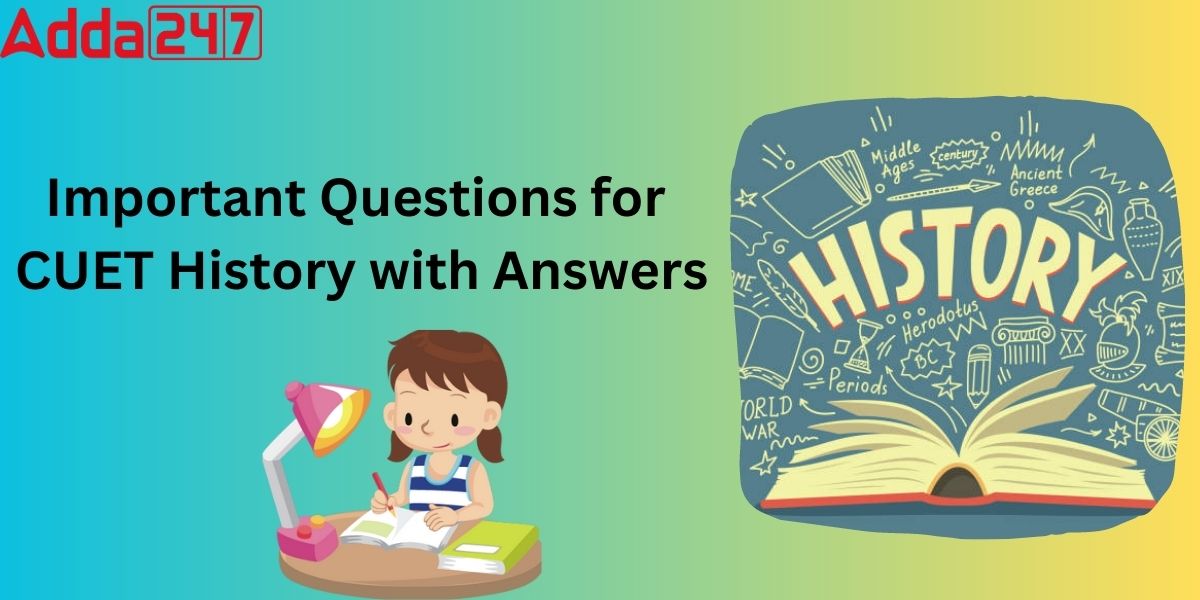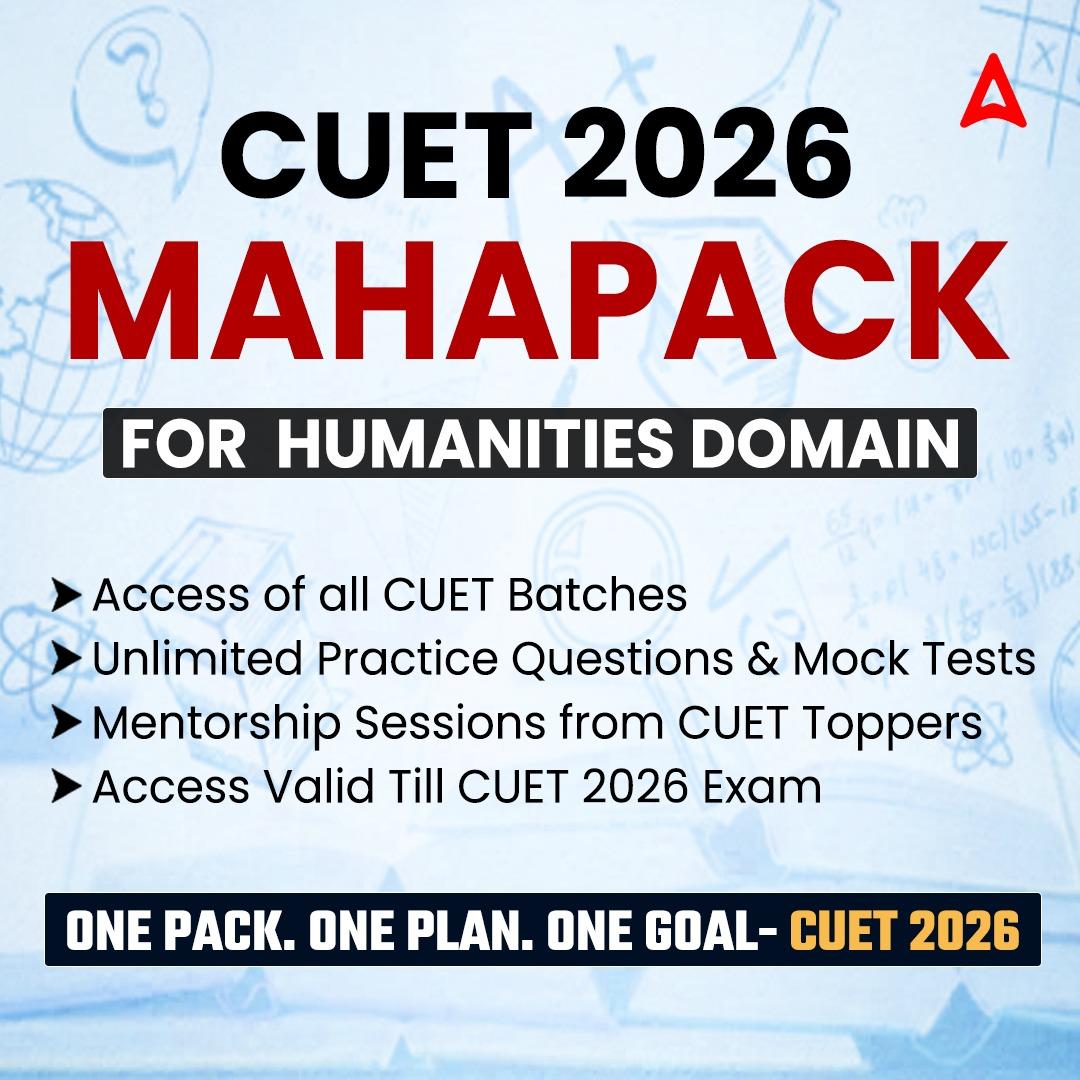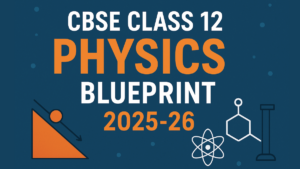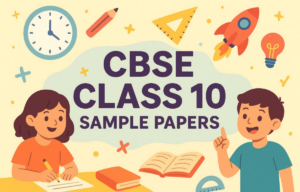Important Questions for CUET History
The CUET UG 2024 is going to take place from 15 May to 31st May 2024, Here Adda247 Experts provide the Important Questions for CUET History with Answers. Candidates who choose history as a domain-specific subject for CUET 2024, must go through the Important Questions for CUET History with Explanation Video. These Important Questions for CUET History with Answers will help students to grasp the topics in a more efficient way.
CUET History Syllabus PDF Download
Important Questions for CUET History Exam Pattern & Syllabus
The CUET Section-II exam covers all domain-specific concepts. History is one of the 27 domain-specific disciplines given by CUET in section II. There are 50 questions on history question papers, 40 of which must be answered. The CUET History exam is worth 200 points. For each wrong response, one point will be deducted. The format of the history paper is Objective questions (MCQs) with a 45-minute time limitation.
The CUET history syllabus would entirely cover the NCERT class 12th curriculum. The CUET History Syllabus is made up of 15 modules. Among the many significant chapters in the CUET history curriculum are Harappan Archaeology, Social Histories Using the Mahabharata, Political and Economic History, Religious Histories, A History of Buddhism, and Mediaeval Society.
Important Questions for CUET History with Answers
Set 1
Q1. Arrange the landmarks in the discovery and conservation of the Vijayanagara empire in chronological order.
(A) Colin Mackenzie’ s Visit.
(B) Alexander Greenlaw takes first detailed photographs.
(C) Conservation begins under John Marshall.
(D) J.F. Fleet begins documenting inscriptions.
(E) Hampi declared as a world heritage site by UNESCO.
Choose the correct answer from the options given below:
(a) (A), (B), (C), (D), (E)
(b) (A), (B), (D), (C), (E)
(c) (E), (D), (C), (B), (A)
(d) (C), (D), (E), (A), (B)
Ans. (b)
Sol. (A), (B), (D), (C), (E) is the correct chronological order.
Q2. Match List-I with List-II.
| List-I | List-II | ||
| (A) | Jagannatha | (I) | A devotee of Shiva |
| (B) | Manikkavachakar | (II) | Anthologies of Alvars |
| (C) | Nalayira Divyaprabandham | (III) | A form of Vishnu |
| (D) | Karaikkal Ammaiyar | (IV) | Woman devotee of Shiva |
Choose the correct answer from the options given below:
(a) (A)-(III), (B)-(IV), (C)-(I), (D)-(II)
(b) (A)-(II), (B)-(I), (C)-(IV), (D)-(III)
(c) (A)-(III), (B)-(I), (C)-(II), (D)-(IV)
(d) (A)-(I), (B)-(II), (C)-(III), (D)-(IV)
Ans. (c)
Sol. (A)-(III), (B)-(I), (C)-(II), (D)-(IV)
Q3. The painting in which Shah Jahan is shown as honouring Prince Aurangzeb at Agra before his wedding was painted by _____________.
(a) Payag
(b) Abdul Hamid Lahori
(c) Abdul Hasan
(d) Hussain
Ans. (a)
Sol. The painting in which Shah Jahan is shown as honouring Prince Aurangzeb at Agra before his wedding was painted by Payag.
Q4. A ‘sahukar’ was someone who acted as both a _____________.
(a) Moneylender and Zamindar
(b) Trader and Zamindar
(c) Moneylender and Trader
(d) Trader and Peasant
Ans. (c)
Sol. A sahukar was someone who acted as both a moneylender and a trader.
Q5. The ‘Late Harappan’ culture is marked by:
(A) Long distance trade and writing were prominent during this phase.
(B) Disappearance of distinctive artefacts of the civilization.
(C) House construction technique deteriorated.
(D) Large public structures were no longer produced.
(E) Overall artefacts and settlement indicate rural way of life.
Choose the correct answer from the options given below:
(a) (A), (B), (C), (D) only
(b) (A), (B), (D), (E) only
(c) (A), (B), (C), (E) only
(d) (B), (C), (D), (E) only
Ans. (d)
Sol. (B), (C), (D), (E) are the correct characteristics of the ‘Late Harappan’ culture.
Q6. Choose the incorrect statements regarding the ‘Subsidiary Alliance System’.
(a) Subsidiary Alliance was the strategy of the British to acquire more territories in India.
(b) Under this system, the British would be responsible for the internal and external protection of Indian rulers.
(c) Nawabs and local rulers were allowed to keep their own army as well.
(d) Nawabs were dependent on the British Army for their protection.
Ans. (c)
Sol. By the terms of the ‘Subsidiary Alliance System’ Nawabs and local rulers had to disband their military forces, allow the British to position their troops within the kingdoms, and act in accordance with the advice of the British Resident who was now to be attached to the court.
Q7. In which year was ‘Hampi’ recognised as a site of national importance?
(a) 1975
(b) 1976
(c) 1979
(d) 1977
Ans. (b)
Sol. In 1976, Hampi was recognised as a site of national importance.
Q8. Where was the Ryotwari Revenue System implemented?
(a) Bengal
(b) Punjab
(c) Bombay Deccan
(d) Sind
Ans. (c)
Sol. The Ryotwari Revenue System was implemented in Bombay Deccan.
Q9. Choose the correct bottom-to-top sequence of the following parts of ‘Stupa’ architecture.
(A) Harmika
(B) Anda
(C) Yashti
(D) Chhatri
Choose the correct answer from the options given below:
(a) (A), (B), (C), (D)
(b) (B), (D), (C), (A)
(c) (A), (C), (D), (B)
(d) (B), (A), (C), (D)
Ans. (d)
Sol. (B), (A), (C), (D) is the correct bottom-to-top sequence of the parts of ‘Stupa’ architecture.
Q10. According to scholars, which script was used to write the earliest inscription discovered in the Indian subcontinent?
(a) Tamil
(b) Pali
(c) Sanskrit
(d) Prakrit
S10.Ans. (d)
Sol. According to scholars, Prakrit was used to write the earliest inscription discovered in the Indian subcontinent.
Q11. Who was B.N. Rau?
(a) Lawyer
(b) Chief Draughtsman
(c) Constitutional Advisor
(d) Cabinet Member
Ans. (d)
Sol. (B), (A), (C), (D) is the correct bottom-to-top sequence of the parts of ‘Stupa’ architecture.
Q12. Which of the following is not correct of the Ryotwari Settlement in the Deccan?
(a) Average income from different types of soil was estimated.
(b) Revenue paying capacity of ryot was assessed.
(c) A proportion of the revenue was fixed as a share of the state.
(d) The amount of revenue demanded was permanently fixed.
Ans. (d)
Sol. In the Ryotwari Settlement, the amount of revenue demanded was not permanently fixed; it varied based on the quality of the land and other factors.
Q13. Which of the following is not a principal center of the Revolt of 1857?
(a) Ambala
(b) Gwalior
(c) Jabalpur
(d) Kochi
Ans. (d)
Sol. Kochi was not a principal center of the Revolt of 1857. The other options—Ambala, Gwalior, and Jabalpur—were more actively involved.
Q14. When was the ‘Hindu Mahasabha’ founded?
(a) 1915
(b) 1916
(c) 1917
(d) 1918
Ans. (a)
Sol. Founded in 1915, the Hindu Mahasabha was a Hindu party that remained confined to North India. It aimed to unite Hindu society by encouraging the Hindus to transcend the divisions of caste and sect. It sought to define Hindu identity in opposition to Muslim identity.
Q15. At burials in Harappan sites the dead were generally laid in pits. Which of the following items has not been found in the excavations of the graves at Harappa?
(a) Micro beads and pottery
(b) Copper mirrors
(c) Shell rings and beads
(d) Pile of gold coins
Ans. (d)
Sol. A pile of gold coins has not been found in the excavations of the graves at Harappa.
Set 2
Q.1. Which of the following statement is correct, regarding the traveller Ibn Battuta?













 CBSE Class 12 Physics Blueprint 2025-26:...
CBSE Class 12 Physics Blueprint 2025-26:...
 CBSE Class 10 Sample Paper 2025-26 with ...
CBSE Class 10 Sample Paper 2025-26 with ...
 Children's Day Speech in English, Check ...
Children's Day Speech in English, Check ...





